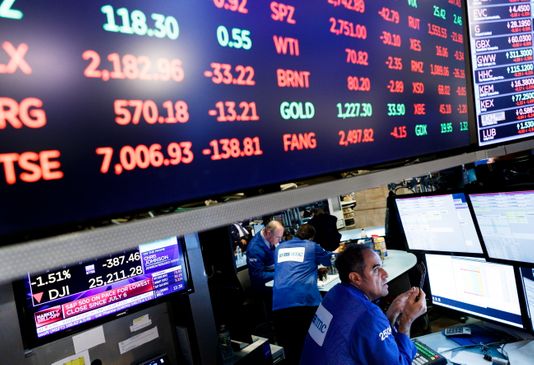
It’s official: The Nasdaq is in a bear market.
The tech-heavy index finished down 195 points, or 3 percent, to 6,333 on Friday. That’s almost 22 percent off its most recent high of 8,109.69 set Aug. 29 of this year.
It’s also the second major stock gauge to fall into bear territory, when an index falls 20 percent or more from its most recent high. The Russell 2000, an index of small-company stocks, passed that milestone last week.
Stocks overall finished lower on Friday, capping a devastating week for the markets as investors succumbed to fears of rising interest rates, slowing global growth and a looming government shutdown.
“I have to say I’m surprised,” said Tatyana Bunich, president and founder of Financial 1 Wealth Management. “I think people expected to see some recovery. They got used to up 300 one day then down 400 the next. But the past couple of days has just been down, down, down.”
The Dow Jones industrial average dropped 414 points, or 1.8 percent, to close at 22,445 Friday. The Standard & Poor’s 500 lost 51 points, or 2.1 percent, to 2,417.
“It’s still not pretty,” said Jerry Braakman, chief investment officer of First American Trust. “Obviously, we’ve had a pretty ugly market since the Fed made its rate-hike decision Wednesday, even though the markets expected it.”
New York Federal Reserve President John Williams on Friday tried to soothe the markets in a speech by saying the Fed is open to reevaluating rate increases next year, depending on how the economy shapes up. Stocks briefly rose on the news, but quickly fell back.
Braakman also noted that some signs of a softening economy have recently popped up, such as November’s disappointing durable goods orders and the flattening yield curve. “The big fear is a potential recession is coming on,” he said.
Making matters worse for investors was the continued drama out of Washington, D.C. On Thursday, Defense Secretary James Mattis abruptly resigned after President Donald Trump unexpectedly ordered U.S. troops out of Syria.
At the same time, lawmakers were scrambling to come up with a plan to prevent a government shutdown starting at midnight. Trump refused to sign a temporary funding bill on Thursday because it didn’t include money for the border wall.
The House then passed a new bill that included $5.7 billion for the wall late Thursday. It’s up for a vote in the Senate, but the bill’s chances of getting 60 votes remain uncertain due to the Democrats’ opposition to the wall funding.
On Friday morning, Trump urged Senate Majority Leader Mitch McConnell to use the so-called “nuclear option” – which requires only a simple majority – to pass the measure.
“When you’re looking at the dynamic coming out of Washington, it’s more uncertainty,” said Timothy Horsburgh, an investment strategist at OppenheimerFunds. “And uncertainty is always the worst outcome for market.”


























